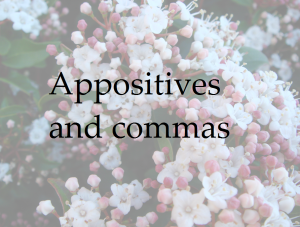Commas
Commas can easily cause confusion. There are specific rules for them, and their placement can make a significant difference in the meaning of a sentence. Whether prolific or sadly lacking, commas can create challenges for writers.
Today I want to cover just one comma rule: how they’re used with appositives.
An appositive is a noun or noun phrase used to further explain, identify or rename the noun directly beside it. It can be at the beginning, the end, or the middle of a sentence. In each case, a comma or commas should be used to separate the appositive from the rest of the sentence.
Examples:
- In the middle of a sentence
My car, a red Holden, was stolen last week.
The phrase, “a red Holden”, is an appositive. - At the end of a sentence
He lived in Raglan, a township on the west coast of New Zealand. - At the beginning of a sentence
An excellent cook, Martha baked every Tuesday.
More examples:
- The team appreciates any sports equipment, bats, balls and wickets, that can be donated via the school.
- The bird, a fat wood pigeon, was often seen down at Butler Park.
Notice how the appositives are rearranged and change in these sentences, depending on order and commas:
- Monica, a lovely waitress, served us at our table.
- A lovely waitress, Monica, served us at our table.
- A lovely waitress, Monica served us at our table.
- We were served at our table by Monica, a lovely waitress.
- We were served at our table by a lovely waitress, Monica.
Sometimes a dash will be used instead of a comma. Dashes can be useful when the appositive itself contains a comma.
- Example:
He lived in Raglan – a township on the west coast of New Zealand.
Restrictive or Non-Restrictive Appositives
In the previous examples, where they’re renaming, explaining or identifying, the appositives are non-restrictive and require a comma. Restrictive appositives are essential to the meaning of a sentence and are not set off by commas.
Example:
- My sister, Louise, came with me.
“Louise” is written here as a non-restrictive appositive, where the writer has only one sister: Louise.
If the writer had more than one sister, the sentence should be written: “My sister Louise came with me”. In the second sentence, “Louise” is important to the meaning of the sentence and therefore a restrictive appositive not requiring any commas.
In short, non-restrictive appositives, clauses or phrases need extra commas – restrictive ones do not.

